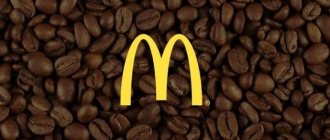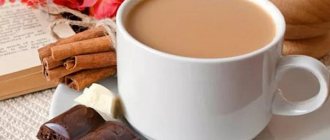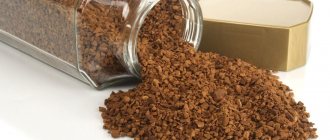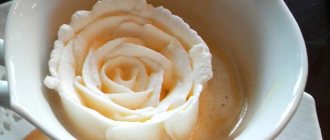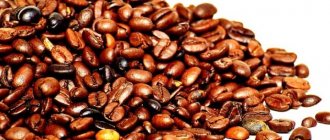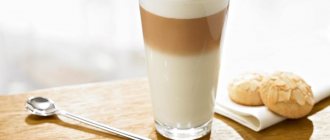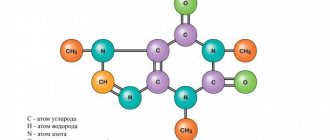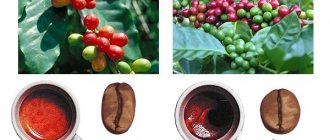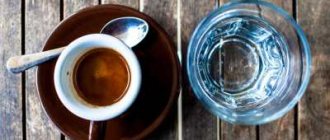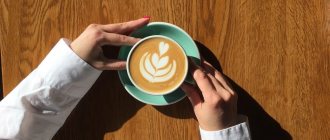Modern man cannot imagine his life without coffee. This aromatic drink is presented in a large assortment, has about fifty variations and can satisfy even the most demanding gourmet needs. However, while there are many positive characteristics, coffee has negative characteristics. These include medical contraindications and dietary requirements. In the second case, you should know its energy value or how many calories are contained in a mug of your favorite drink, ways to reduce this indicator and what it can be combined with without harming your figure.
What is espresso coffee
The birthplace of espresso is Italy. In this country, a recipe was invented that allows you to prepare a fairly strong coffee drink. Its history begins in 1901. Then an Italian entrepreneur received a patent for a new invention - a coffee machine. In it, water under pressure passed through coffee powder.
Translated from Italian, espresso means expressed, compressed, concentrated. This is a drink that is prepared from natural grains and water in strictly defined proportions.
No more components are added to the composition.
Types of drink
In addition to the classic version, the following types of espresso are distinguished:
- ristretto. Differs in saturation. Less water is used;
- Lungo. Less strong. In this case, more water is added;
- double, triple espresso . The proportions are respected, but the portion is two or three times larger.
Ristretto
Lungo
In addition, based on this drink you can prepare:
- coretto. A little alcohol is added to the composition;
- Romano. In addition to the main components, lemon is used;
- Americano. It's essentially watered down espresso;
- cappuccino. Black coffee is covered with milk foam;
- latte. It also contains frothed milk.
Energy value of various types
Latte has a composition rich in protein compounds; the drink contains a high concentration of milk (up to half a mug). A large serving made according to a standard recipe contains 175-250 kcal. The product contains dietary fiber, water, fatty acids, vitamins (E, B, C, PP), and mineral components.
A serving of latte macchiato contains 29 kcal. Contains polyunsaturated acids, vitamins (groups B, C, K, E), minerals, dietary fiber, etc.
The ratio of BJU in latte macchiato is as follows:
- protein compounds – 1.5 g;
- fats – 1.4 g;
- carbohydrate compounds – 2 g.
Calorie content of an Americano is 21.05 kcal. Protein content - 1.28 g, fat - 1.47 g, carbohydrate compounds - 0.7 g. The product is rich in saturated and polyunsaturated acids, contains water, vitamins (PP, C, group B, choline), mineral components (zinc , manganese, phosphorus, etc.).
Coffee drink frappe:
- proteins – 20 g;
- carbohydrates – 20 g;
- fats – 15 g.
A high-calorie drink is mocaccino - standard servings contain 250 ml. The product contains espresso brewed in a coffee maker, chocolate syrup, and natural milk. The nutritional value of mocaccino can be increased by adding additional ingredients to improve the taste (nuts, chocolate chips, ground cinnamon, cream, marshmallow balls). 100 g of drink contains proteins - 2.98 g, fats - 10.57 g, carbohydrate compounds - 46.42 g.
Standard glace – medium calorie; it contains proteins (4.8 g), carbohydrates (19.63 g), fats (5.06 g). The nutritional value of the product may vary if you change the proportions of espresso, ice cream, decorate with caramel crumbs, coconut flakes, chopped cinnamon, nuts, cocoa powder or grated dark chocolate. Some cooking options involve adding liqueurs or syrups to the glace.
Cappuccino has a rich composition. Espresso, milk or cream are used in preparation. Depending on the variety, the drink may include nut fillings, chocolate chips, and chopped cinnamon. The composition has a high nutritional value: saturated and polyunsaturated acids, vitamins (B, C, E, etc.), mineral components (zinc, iron, sodium, etc.).
The energy value of cappuccino is determined by the following BJU:
- protein compounds – 3.1 g;
- fats – 5.56 g;
- carbohydrates – 84.74 g.
Espresso is a low-calorie drink: coffee without sugar contains 7 calories per serving. 100 g of product contains proteins (0.2 g), carbohydrate compounds (0.2 g), fats (0.5 g).
Espresso contains nutritional components in small concentrations: starch, monosaccharides, fatty and organic acids, vitamins, minerals (phosphorus, calcium, potassium, etc.). The energy value of espresso varieties with increased or decreased water concentration differs slightly: con pana has a higher calorie content because Milk foam and whipped cream are used in preparation; for romaine, the ingredients include lemon zest or juice.
Frappuccino is one of the most nutritious drinks. The product is prepared on the basis of classic espresso, medium-fat cream, and syrup.
The nutritional value of the coffee tore variety is average - 100 per 100 ml. The drink has milk foam and low sugar concentration.
The energy value of Irish coffee increases due to the inclusion of alcoholic drinks (liqueur, cognac) and whipped medium-fat cream.
Rough coffee has a low calorie content (about 85 calories) and consists of classic espresso, low-fat cream and sugar with vanilla additives.
Do you count calories when drinking coffee drinks? Write your answers in the comments to the article.
Espresso volume
Classic Italian espresso 35-40 ml. This setting may change depending on preference. It is prepared differently in different countries:
- in most European countries the serving is 40-50 ml;
- in northern Europe they prepare 60-80 milliliters;
- Americans have a serving of espresso of 80-100 ml;
- In the Russian Federation, the drink is prepared according to the classic recipe (50 ml), but in some coffee shops you can find options up to 80 ml.
Cooking rules
To prepare a classic espresso, you need to choose the correct grinding beans and clearly calculate the proportions. In addition, the container in which the drink will be served also deserves attention.
Coffee grinding
Espresso beans must be ground to a strictly defined degree. The final result directly depends on this. If the fractions turn out to be excessively large, then they simply will not have time to impart aroma and taste to the water. Accordingly, the coffee will be watery. Grains that are too small will result in intense extraction. The result is a rough, bitter drink.
The grains should be ground finely, but not to a powdery state.
The ideal degree of grinding can be easily determined by touch. Just take a pinch in your hands and rub the fractions between your fingers:
- if the grains are similar to sugar, then the grains are crushed too coarsely;
- Fractions similar to flour are also not suitable. They are very small;
- Powder resembling “Extra” salt is an ideal option.
How many grams of coffee do you need per cup?
Espresso coffee should be used in strictly defined quantities. For one cup of 35-40 ml you need 7 g. If a double portion is prepared, the amount of grains increases to 14-15 g.
When using Arabica coffee, 10 grams of coffee are consumed per espresso. This variety is not very strong. Therefore, the number of beans should be large.
Espresso cups
A standard espresso shot is only 40 ml. Accordingly, small-sized dishes are chosen for it. To ensure that the drink retains its original taste and aroma, cools slowly and looks attractive, it is poured into white thick-walled cups made of ceramic.
Other materials are not suitable for coffee. In them it will cool too quickly. Porcelain, in principle, can be used at home, but only if the drink is drunk immediately after preparation.
Type of grain and roasting method
There is a certain difference between Arabica and Robusta beans:
- Arabica itself is even more oily, contains more sweetness, and because of this is more fragrant, with a rich taste.
- Robusta is more “caffeinated”, there are less oils, and there is a minimum of sweets. Least valuable from both trade and nutritional perspectives.
The differences in calories are about 0.3 kcal per serving, so they can be considered insignificant. For a daily requirement of 1700-1900 calories, 2 or 2.3 is not important. Even if you drink 6 cups and get a difference of 1 point.
Small differences also occur with different roasting methods. The darker the roast, the longer the grain was subjected to heat treatment. When heated, the pores expand, break, open, oils come to the surface, bake, caramelize, hence the black color and amazing smell. When grinding, these substances transfer into water, and the nutritional value of the drink depends on them.
The darker the roast, and the longer the roasted grain sits, the more oils are released, increasing fat content and nutritional value. But the difference, again, is in tenths. You may not take this into account when calculating.
How to make espresso at home
It is not at all difficult to prepare espresso in a Turk, French press and more modern units. To do this, you just need to understand the features of the technology. The result will certainly please you.
In the coffee machine
The easiest way to prepare the perfect espresso is in a coffee machine. The device will do all the work. You just need to place the grains in it and turn on the start.
Beans should be ground immediately before cooking. One serving of the drink consumes 7 g of coffee powder. It needs to be placed in a holder and installed in the coffee machine. After this, the brewing process will begin. As a rule, after 20-30 seconds the coffee is ready.
In the coffee maker
You can easily prepare espresso at home using any type of coffee maker. The description of the cooking technology is as follows:
- Pour the crushed grains into the holder.
- Tamper the coffee powder. It should be located evenly in the holder. There should be no unevenness.
- Clean the divider by spilling water.
- Insert the holder into the unit and screw it tightly.
- Turn on the water supply.
- Carry out the spill for a maximum of half a minute.
In the French press
If you don’t have modern coffee machines in your home, you can use a recipe for brewing espresso coffee in a French press. The following ingredients are used:
- 4 teaspoons of ground grains;
- 500 ml water.
The cooking method involves performing the following actions:
- Rinse the glass with hot water.
- Place coffee powder in the bottom of the French press.
- Pour hot, but not boiling, water into the container.
- Stir the resulting mixture.
- Lower the filter slightly and wait five minutes.
- Lower the filter all the way and pour the coffee into cups.
In Turk
You can brew the drink without a coffee machine. Preparing espresso in a Turk is quite simple. You will need the following ingredients:
- 10 g crushed grains;
- 60 ml water.
The following actions are performed:
- The cezve is placed on the stove and warms up a little.
- The crushed grains are poured into the dishes. After this, the Turk is again placed on the fire.
- When the coffee powder has warmed up, pour cold water into the cezve.
- When foam appears on the surface, the Turk is set aside.
- The drink is mixed and put back on the stove, and removed from it when foam appears.
- The finished coffee is poured into a cup.
How many calories are in a cup of natural black coffee with additives?
Any sweet additives increase the calorie content of the drink.
One level teaspoon, or one stick, adds approximately 20 kcal to the drink, a heaped teaspoon - 27 kcal. Two teaspoons, or 2 stick sachets, are already 40 kcal. Adding one teaspoon of honey, which is saturated with sugars and carbohydrates, brings the calorie value to 67 Kcal.
When adding syrups, the energy indicators will be even higher, but it is difficult to accurately calculate their indicator, since their range is huge.
Syrups, in addition to other ingredients and chemical additives, have a high sugar content. For example, caramel syrup adds 90 kcal.
Submission rules
Espresso is served according to certain rules:
- a spoon is placed under the handle of the cup on the saucer, and portioned sugar is placed on the other side;
- hot coffee is served immediately after the preparation process is completed;
- place a glass of water separately;
- The cups are preheated. For this purpose, you just need to pour boiling water over them or use the special heating function in the coffee machine;
- The cups are filled to a maximum of two-thirds.
